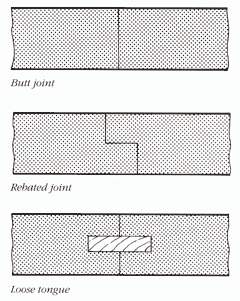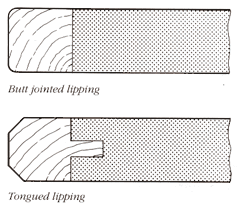Fixing
Edge jointing and lipping
Edge jointing
| The availability of MDF in large sheet sizes which can be cut down to an infinite number of panel sizes for all applications has eliminated most requirements for edge jointing of MDF pieces in the plane of the board. Nevertheless where edge jointing is necessary, the following recommendations will ensure satisfactory performance of simple butt joints or joints with loose tongue or dowel reinforcement. |  |
| 1. | The edges should be accurately machined, parallel to each other and perpendicular to the board surfaces. |
| 2. | The width of grooves machined in MDF should be limited to about one third of the thickness of the board. The depth of groove should not exceed one half of the board thickness. |
| 3. | Dowels and tongues for insertion into holes or grooves in the edges of MDF should fit easily as tight fitting inserts may result in delamination within the MDF. |
| 4. | A high solids content adhesive with gap filling properties should be used. |
| 5. | Mating pieces should be accurately located and held under pressure while the adhesive is setting. |
| 6. | Adhesive bonded joints should be allowed to condition for several days before sanding and finishing to avoid the appearance of 'sunken' joints. This treatment is essential when using high gloss finishes on the jointed MDF parts. |
Solid wood lipping
| MDF can be used for most applications with directly moulded and finished edges without the need for adhesive bonded solid wood lippings which are normally required with moulded edge particleboard panels. The well compacted edges of MDF ensure good machining with well defined profiles which can be finished to a high quality level. Where required to satisfy customer requirements, solid wood lippings can be adhesive bonded to MDF edges for the attachment of heavy duty fittings or for specialist applications in reproduction furniture where the nature of the furniture requires a decorative wood edge. The recommendations for edge jointing MDF pieces apply equally to solid wood lippings with the following additions. |
 |
| 1. | The solid wood lippings should be straight and free from grain irregularities. |
| 2. | Large movement timbers, for example beech, maple or ramin should not be used on thick MDF panels, typically in excess of 25 mm, because of the movement incompatibility between MDF and these timbers. |
| 3. | Wood used for lippings should be properly kiln dried to a moisture content appropriate to the place of use. In Northern Europe, wood moisture contents in the range 10 ±2% are recommended for general use with lower moisture contents preferred for applications in well heated premises and for most applications in Southern Europe. |












